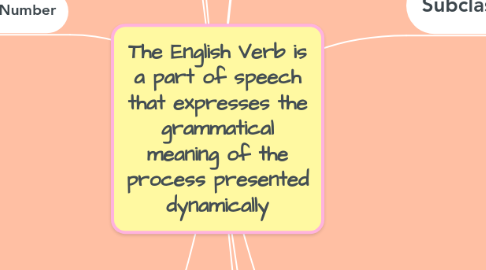
1. Phrasal Verbs
1.1. analytical
1.1.1. head-verb have, give, take and some others + noun
1.1.2. head-verb with a verbal postposition
1.2. syntactic
2. Notional Verbs. They have full lexical meaning of their own: buy, eat, do, give, go, live, love, make, permit, push, see, study, take, try, understand, write. Notional verbs express an action (give, study, take) or a state (love, see, exist).
2.1. subject - process relations
2.1.1. actional
2.1.2. statal
2.1.3. "processes"
2.1.3.1. mental
2.1.3.2. senual
3. Person and Number
3.1. Subsystems (Present Tense)
3.1.1. modal verbs that have no personal inflexions
3.1.1.1. can
3.1.1.2. may
3.1.1.3. dare
3.1.1.4. need
3.1.1.5. will
3.1.1.6. ought
3.1.1.7. must
3.1.2. verbal lexeme "be"
3.1.2.1. am
3.1.2.2. is
3.1.2.3. are
3.1.3. - (e) s
4. Voice
4.1. passive
4.2. active
4.3. English
4.3.1. transitive
4.3.1.1. Transitive verbs require a direct object. For example: She made coffee. He reads books. Take a pen and write a letter.
4.3.2. intransitive
4.3.2.1. Intransitive verbs cannot take a direct object. They may be used without an object or may be followed by a prepositional object or by an adverbial modifier. For example: They have already arrived. I'll speak to him. He works slowly.
4.4. Russian
4.4.1. transitive
5. Means of Expressing the Future
5.1. shall/will + infinitive
5.2. to be going to
6. Finite
6.1. verb-predicate function
7. Non-finite
7.1. potentially predicative function
8. Subclasses of Verbs
8.1. full nominative (notional verbs)
8.1.1. derivationally open
8.2. partial nominative (semi-notional and functional)
8.2.1. derivationally closed
8.2.1.1. Auxiliary verbs are so called because they help to form the various tenses, moods, and voices of other verbs. The principal ones are be, do, and have.
8.2.1.2. There is a further set of auxiliary verbs known as modal verbs or modal auxiliary verbs. These combine with other verbs to express necessity, possibility, intention, or ability. The modal auxiliary verbs are must, shall, will, should, would, ought (to), can, could, may, and might.
8.2.1.3. Link verbs are verbs that express a state of being. They are called "link" verbs because they link the subject of the sentence to a word or phrase in the predicate that renames or describes the subject (tells us more about the subject's "state of being").
8.2.1.4. Semi-notional verbid,intrducer verbs are distributed among the verbal sets: of discriminatory relational semantics (seem, happen,turn out,etc) of subject-active relational semantics (try,fail,manage,etc),of phrasal semantics (begin,continue,stop,etc)
9. Time Denotation
9.1. absolutive
9.1.1. the sphere of present
9.1.2. the sphere of past
9.1.3. the sphere of future
9.1.4. Examples: now, last week, in the past, very soon, etc.
9.2. non-absolutive
9.2.1. relative
9.2.1.1. events either prosceding of following the others (before that, sometime later etc.)
9.2.2. factual
9.2.2.1. states the time of an event (at the epoch of Napoleon, in 1066 etc.)
10. Aspect
10.1. indicates the character of the action (e.g., repetition, duration, completion) and can be simple, continuous, perfect, or perfect continuous.
10.1.1. limitive/unlimitive
10.1.2. perfect/non-perfect
10.1.3. continuous/non-continuous
10.2. Categories
10.2.1. the aspective category of development
10.2.2. the category of retrospective coordination

